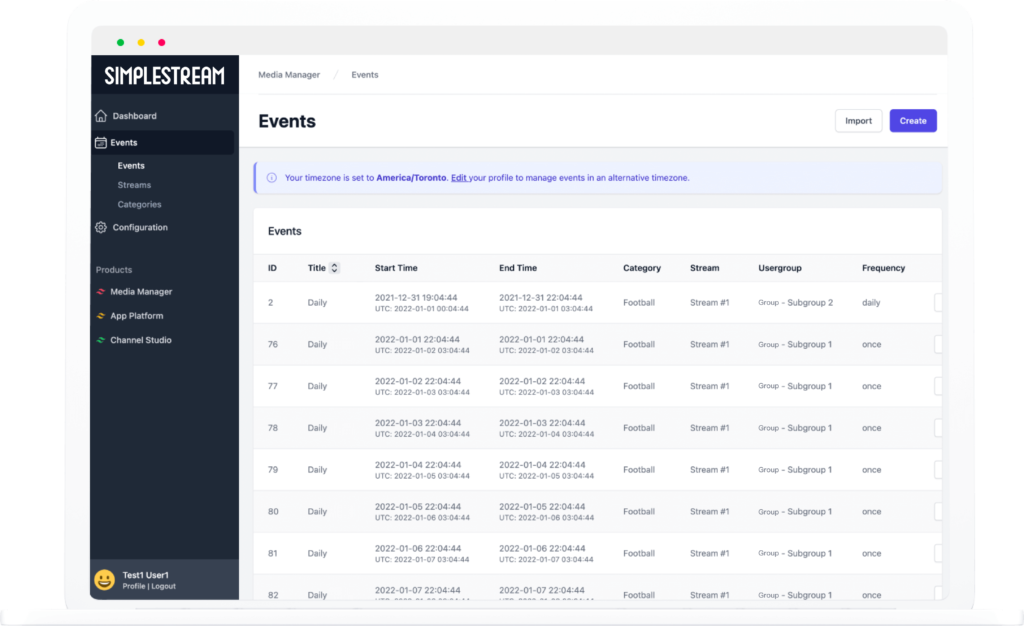
Adam Smith, Founder & CEO, Simplestream
What are the biggest challenges in managing live event schedules with content provided by multiple operators? The answer can be rather straightforward, and it comprises several key aspects, mostly related to the pain points platform owners are facing today when distributing content across digital channels.
Firstly, ensuring that the live content ingestion and integration are handled with the right set of tools is the foundation for granting flexibility when delivering multiple outputs. In a workflow that in normal circumstances heavily relies on manual processes, with several teams involved, quality and reliability of content provided by different operators need to be ensured throughout. And ultimately, scheduling and distribution – across different touch points – are a focus for successful platforms. With often large numbers of stakeholders deployed to manage the workflow, a permission-based system becomes necessary to support seamless operation, avoiding jeopardising the overall effectiveness of the platform.
Media Manager for live events orchestration
Can a backend solution with an easy-to-navigate UI make life easier? It certainly can, and that’s the reason why at Simplestream we built our value proposition focusing on the foundation of a flexible, modular content management system, Media Manager. A product that has progressively become more powerful for operators to own the entire workflow for their video content, both on demand and live.
Its most recent evolution, Live Scheduler, is a bespoke enhancement for the built-in module for live events and has marked a new milestone in solving the challenges outlined above. It has adapted Media Manager to an even more flexible architecture, one that can also act as an orchestration layer, fully self-service for the client. It provides an opportunity for platform owners of any size to bring multiple event data management capabilities under the same roof. With additional benefits when it comes to monitoring, scheduling, and permissions for different teams.
A use case in the telecommunications space
A telco based in the North American region chose Simplestream to enhance an existing set of OTT workflows, including all the origin servers, APIs, and encoders. With no existing UI, and a backend system relying solely on manual processes, the organisation was limited in the number of content partners it could onboard, and looked for a solution that could be cost-effective and ‘self-service’. The objective was to streamline an otherwise cumbersome (and prone to error) process of manually inputting the documentation to correctly set up live schedules for multiple events in sport, but also across faith, news, and entertainment in general.

Thanks to Live Scheduler, every content provider can access an easy-to-navigate platform, operating in a cloud-based, fully agnostic environment. The backend acts as middleware, with custom UI, and the added benefit of reducing the margin of error to a minimum, as well as allowing the client to limitlessly expand the number and scale of the content providers.
The added value naturally sits at the heart of the solution. On one hand, Media Manager acts as a bridge between the source of content and the output of the broadcast. On the other, teams of operators from third-party providers can seamlessly access the backend and see – at a glance – what the scheduling parameters are, ensuring a smooth operation. It was key for the client to be able to open a gateway for its content providers to fully manage their events (from their creation to updates, deletion and monitoring) against a pre-integrated API. The information is subsequently passed through the CDN for the final stages of the process before it gets delivered to IPTV or apps.
A permission-based structure provides the third parties with multiple tiers of access: from user groups auditing, to seamlessly monitoring the health and status of the service, with the ability to roll back to a previously auto-saved version of the schedule in case of mistakes.
On the horizon
Content aggregation is among the most debated topics in the streaming space today. The future might hold something big for platforms looking to simplify and accelerate content onboarding, becoming themselves an aggregator. The aforementioned solution for the orchestration of live events goes perfectly hand in hand with the needs and wants of big telcos, of course, but appeals to media brands or rights holders in the live news, sports, betting, and entertainment spaces too.
Picture this: an operator wants to promote an innovative service that relies on user-generated content to populate daily programming schedules. Media Manager and its Live Scheduler can become a powerful ally for content creators (regardless of their experience) who can access the backend from anywhere, holding basic camera equipment or even just a smartphone with a data connection. The solution would undoubtedly allow them to spin up a solution that’s cost-effective, suitable to be permanent or ‘event-basis’ (i.e. in the case of multi-sport events with a set timeframe, to be shut down as they end).
As a next step in the evolution of such a product, we naturally find virtual channels with optional monetisation opportunities via ad insertion. Simplestream’s Channel Studio can support more innovative approaches to a deeper user experience. With multiple live events happening in one or more days, is there a chance to bring everything together, in the same pre-built playlist of content? The answer, again, is yes. And with the invaluable benefit of content providers adding any video on demand (VOD) asset to fill potential downtime. All in a useful queue system to be approved by the platform operators at a higher level.









